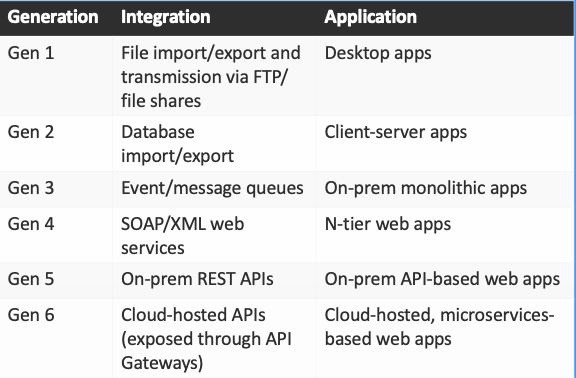5 Must-Haves for Every App Modernization
All business-critical software applications and systems should be kept up to date with functional features and technologies. If systems become outdated, you limit the features, performance, scalability and usability – all leading to more development and maintenance time.
So how do you keep from falling behind? Modernize your applications using the latest technologies. This article will walk through the benefits of staying current with new advancements, so your technology continues to meet the needs and demands of your growing business and your users. Here's our 5 must-haves for your technology modernization plans.
1. Your technology must fit your business

1. Your technology must fit your business
Businesses of every size and industry require multiple software systems to run efficiently. Standard software applications such as accounting, finance, HR, and payroll systems can be bought from third-party software vendors. These out-of-the-box offerings are usable with little to no customization. However, businesses also require many custom software systems to meet specific needs. In such cases, they must identify the features and functionality to implement, and work with either in-house teams or hire external software development firms to build custom software. In either case, you must use the right tools, technologies, architectures, designs, coding standards and infrastructure hosting platforms for implementation. This way, teams can easily maintain and scale the technology to meet growing workload demands.
2. Your technology must grow with you

2. Your technology must grow with you
As businesses evolve, the software systems supporting their business operations must also evolve to provide the features and functionalities required for them to stay relevant. New features and changes or enhancements to existing features must be implemented on a regular basis after the initial release of any custom software to meet this need. Many such systems may get integrated with other systems (both internal and external) to provide seamless functionality across systems. If the initial system was built with the right tools, technologies, architectures, designs and coding standards – and if these guidelines are strictly followed throughout the enhancement and integration cycles – then the software may continue to perform well and meet the business needs for a long time. But often, trade-offs are made to meet project timelines, budget limitations, time-to-market, etc. This leads to sub-optimal quality and technical debt.
3. Your technology must limit technical debt

3. Your technology must limit technical debt
When there is technical debt, every future enhancement may add more technical debt. It's like putting multiple layers of bandages to cover a wound. This makes it increasingly difficult to implement changes or enhancements, and it takes longer to implement even small changes. It can also lead to errors, and the overall performance and scalability will start to decline. We know what that means: more money to maintain the system in the current state. Companies then beef-up the infrastructure by upgrading the servers, adding more memory and more servers, to compensate for the performance and scalability issues. But over time, those investments start to produce diminishing returns. It is no longer worth investing in the same path. Companies must decide if the software is important for the business. If so, it is time to modernize with the latest technologies to prevent the technical debt-related issues that have been negatively affecting the current version.
4. Your technology must evolve – as it always has

4. Your technology must evolve – as it always has
Thanks to the rapid evolution of technology, what’s current today becomes “legacy” in just a few years. New tech provides significantly better features and capabilities and it requires less time and effort than ever to implement. So, once you determine you need to modernize your software systems, you must determine which technologies, methodologies, architectures and hosting platforms will provide the best combinations for your specific business needs. The history of evolution is substantial. Suffice to say, each wave of technology modernization came about to solve a previous tech problem or need. Desktop applications were developed because everyone had a personal computer and wanted to “digitize” their processes. This led to massive data duplication, inconsistencies and security problems.
5. Your technology must perform

5. Your technology must perform
Modern cloud platforms offer a combination of virtualized infrastructure combined with ready-to-use services and development technologies. These allow you to:
What generation are you?

What generation are you?
As an IT or business leader, determine where you stand in the modernization evolution, and see what's available so you can better meet business and user needs for the next decade. Ask yourself:
| What challenges need to be solved?
| Would better hosting platforms for apps help free-up infrastructure teams and developers to focus on building applications faster?
| Is it time to enable faster, simpler integrations by building APIs? Or would smaller applications like microservices be preferred for quicker deployment?
| Are application deployments manual and cumbersome? Could any tasks be automated and simplified using DevOps? Or are engineers still using custom security implementations to secure applications (in which case, it’s time to de-couple applications from identity and access management)?
The lead cloud providers have done an excellent job of providing Identity and Access Management (IAM)-as-a-Service offerings, like Microsoft's offering in Azure for corporate domain level security, single-sign-on and multi-factor authentication. This all helps secure enterprise applications efficiently and enable cross-company collaboration using Azure Active Directory Business-to-Business (B2B) service. Plus, it integrates custom applications with Azure Active Directory B2C service to securely expose your applications to end users. This leads to speed and cost efficiencies that were not possible with on-prem data center setups and traditional ways of building, deploying and securing applications.
If technology and application modernization is in your horizon, consider how your technology not only fits your business needs today, but also how it can evolve for the challenges of tomorrow.
Ready for what's next?
Together, we can help you identify the challenges facing you right now and take the first steps to elevate your cloud environment.


